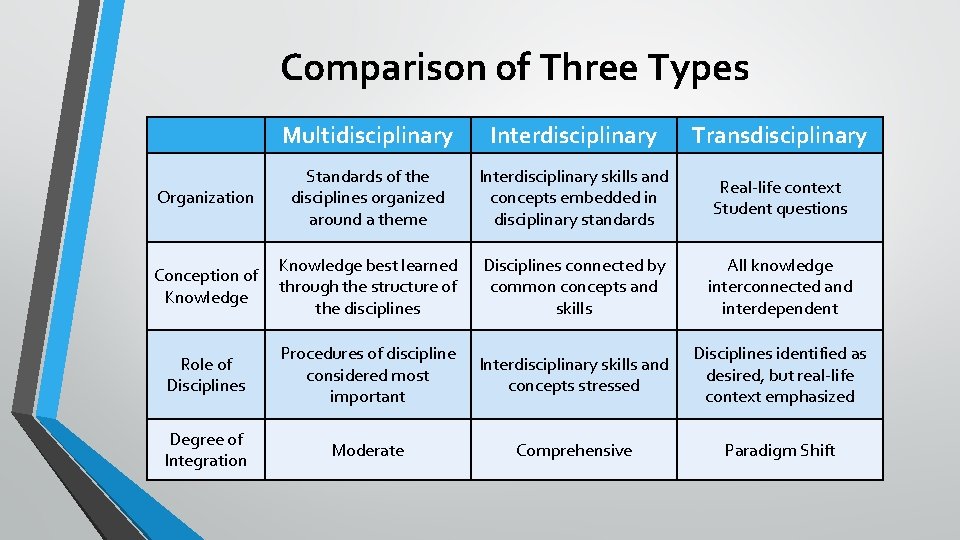Why Interdisciplinary And Transdisciplinary Approaches Matter

Table of Contents
The Power of Interdisciplinary Collaboration
Interdisciplinary collaboration is the cornerstone of effective problem-solving in today's complex world. It breaks down the traditional silos that often separate academic disciplines, allowing for the cross-pollination of ideas and the integration of diverse perspectives.
Breaking Down Silos
Interdisciplinary research thrives on the synergy created when experts from different fields work together. This collaborative approach fosters new perspectives and insights that would be unattainable within the confines of a single discipline.
- Example 1: Medical research increasingly relies on the synergy between biologists and engineers, leading to advancements in bioengineering and personalized medicine.
- Example 2: Urban planning benefits significantly from integrating sociological insights into architectural design, leading to more sustainable and socially equitable cityscapes.
- Example 3: Climate scientists collaborate with economists and policymakers to devise effective climate mitigation strategies.
The benefits of this collaborative approach are clear: diverse skill sets and knowledge bases converge, leading to more robust and innovative solutions. The value of cross-pollination of ideas cannot be overstated, leading to breakthroughs that would be impossible to achieve through single-disciplinary work alone. This fosters effective interdisciplinary research and collaborative research, driving cross-disciplinary collaboration and knowledge integration.
Transdisciplinary Approaches: Beyond Disciplinary Boundaries
While interdisciplinary approaches foster collaboration within academia, transdisciplinary approaches extend beyond these boundaries to encompass stakeholders from diverse sectors. This participatory approach recognizes that real-world problems are rarely confined to a single discipline and require the involvement of various actors.
Engaging Stakeholders
Transdisciplinary research involves actively engaging stakeholders including community members, policymakers, industry representatives, and other relevant actors. Their participation ensures that solutions are not only academically sound but also practically feasible and socially acceptable.
- Example 1: Effective climate change mitigation strategies require collaboration between scientists, policymakers, businesses, and communities.
- Example 2: Sustainable development projects necessitate the integration of ecological, economic, and social perspectives, involving local communities in the planning and implementation process.
- Example 3: Public health initiatives benefit from the engagement of healthcare professionals, public health officials, community leaders, and affected populations.
The importance of participatory research in transdisciplinary work cannot be overstated. It leads to the co-creation of knowledge, where insights from diverse perspectives are integrated into the problem-solving process. This participatory approach allows for more effective solutions and fosters a sense of ownership among stakeholders. Keywords that define this approach include transdisciplinary research, participatory research, stakeholder engagement, community-based research, and the co-creation of knowledge.
Addressing Complex Challenges with Integrated Solutions
Many of today's most pressing challenges, such as climate change and public health crises, are complex systems that cannot be addressed effectively through a narrow, single-disciplinary lens. These problems demand multifaceted, holistic approaches.
The Limitations of Single-Disciplinary Approaches
Focusing solely on one aspect of a complex problem often ignores crucial interdependencies and unintended consequences. A holistic approach is vital.
- Example 1: Addressing climate change requires integrating insights from climatology, economics, sociology, and political science.
- Example 2: Combating a pandemic demands the collaboration of epidemiologists, virologists, healthcare professionals, and public health officials.
- Example 3: Achieving the Sustainable Development Goals requires a comprehensive, integrated approach that considers economic, social, and environmental factors.
A narrow focus often overlooks critical interconnectedness. The adoption of a holistic perspective, encompassing systems thinking and an understanding of complex systems, provides a path toward building integrated solutions focused on achieving sustainable development goals.
Fostering Innovation through Interdisciplinary and Transdisciplinary Thinking
The interaction of different disciplines sparks creativity and fuels innovation. By bringing together diverse perspectives and methodologies, interdisciplinary and transdisciplinary approaches unlock new possibilities and lead to groundbreaking solutions.
New Knowledge and Breakthroughs
The combination of diverse perspectives and methodologies results in new discoveries and technological advancements.
- Example 1: The development of new materials often involves collaborations between chemists, physicists, and engineers.
- Example 2: Advancements in artificial intelligence require expertise in computer science, mathematics, and cognitive science.
- Example 3: Solutions to global food security issues require collaboration between agricultural scientists, economists, and policymakers.
The combination of different viewpoints and approaches often leads to unexpected breakthroughs and innovative solutions. This synergy fosters innovation, enhances creativity, sharpens problem-solving skills, and leads to significant technological advancements and scientific breakthroughs.
Conclusion: The Importance of Choosing Interdisciplinary and Transdisciplinary Approaches
In conclusion, interdisciplinary and transdisciplinary approaches are not merely academic trends; they are essential strategies for addressing the complex challenges facing our world. By fostering collaboration, integrating diverse perspectives, and embracing a holistic view, these approaches unlock the potential for impactful solutions and groundbreaking innovations. They are crucial for navigating the complexities of the 21st century and building a more sustainable and equitable future. Embrace the power of interdisciplinary and transdisciplinary approaches to drive meaningful change. Learn more about implementing interdisciplinary and transdisciplinary methodologies in your work by exploring resources from [link to relevant resources].

Featured Posts
-
 2025 In En Sik Nevresim Takimi Modelleri Gencler Ve Aileler Icin
May 19, 2025
2025 In En Sik Nevresim Takimi Modelleri Gencler Ve Aileler Icin
May 19, 2025 -
 Orlando International Fringe Theatre Festival History Highlights And Loch Haven Park
May 19, 2025
Orlando International Fringe Theatre Festival History Highlights And Loch Haven Park
May 19, 2025 -
 Jyoti Malhotra You Tubers Alleged Leak To Pakistan Apps And Details
May 19, 2025
Jyoti Malhotra You Tubers Alleged Leak To Pakistan Apps And Details
May 19, 2025 -
 Isguecue Piyasasi Icgoerueleri Dijital Veri Tabani Sunumu Ledra Pal Carsamba
May 19, 2025
Isguecue Piyasasi Icgoerueleri Dijital Veri Tabani Sunumu Ledra Pal Carsamba
May 19, 2025 -
 International Asexuality Day Resources And Support For The Asexual Community
May 19, 2025
International Asexuality Day Resources And Support For The Asexual Community
May 19, 2025
